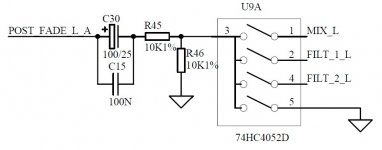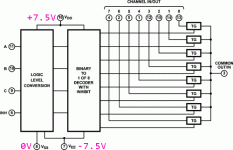Hi everyone,
I'm happy to ask a question for the first time 🙂
I'm designing a dj mixer and came across a problem with audio signals switching.
Above is a part of a well known mixer that is using thoses 74hc4052. The signal comes straight from the output of a TL072 and goes to another op amp on every switch output. My concern is that the datasheet specify an input voltage from gnd to Vcc. So how does this ic can be used for audio signals since they are AC?
I'm sure i'm missing something, sorry if my english's bad and thanks in advance.
I'm happy to ask a question for the first time 🙂
I'm designing a dj mixer and came across a problem with audio signals switching.
An externally hosted image should be here but it was not working when we last tested it.
Above is a part of a well known mixer that is using thoses 74hc4052. The signal comes straight from the output of a TL072 and goes to another op amp on every switch output. My concern is that the datasheet specify an input voltage from gnd to Vcc. So how does this ic can be used for audio signals since they are AC?
I'm sure i'm missing something, sorry if my english's bad and thanks in advance.
I can't open the image you linked to. You can also post them on the forum itself, by clicking Go advanced and Manage attachments.
In any case, a 74HC4052 can handle negative voltages when there is a negative supply connected to pin 7, VEE. With pin 16 (VDD) at +5 V and VEE at -5 V, it can handle anything between +5 V and -5 V, see https://assets.nexperia.com/documents/data-sheet/74HC_HCT4052.pdf
I usually use a pair of Zener diodes biased at relatively small currents as power supply for analogue multiplexer ICs, to reduce the risk of anything weird happening when the input signal exceeds VDD or goes below VEE. In particular, the built-in ESD protection diodes will then effectively clamp excessive input signals and the risk of latch-up will be very small.
In any case, a 74HC4052 can handle negative voltages when there is a negative supply connected to pin 7, VEE. With pin 16 (VDD) at +5 V and VEE at -5 V, it can handle anything between +5 V and -5 V, see https://assets.nexperia.com/documents/data-sheet/74HC_HCT4052.pdf
I usually use a pair of Zener diodes biased at relatively small currents as power supply for analogue multiplexer ICs, to reduce the risk of anything weird happening when the input signal exceeds VDD or goes below VEE. In particular, the built-in ESD protection diodes will then effectively clamp excessive input signals and the risk of latch-up will be very small.
Last edited:
ok I looked at it again for 5 minutes to finally read the first listed feature. Thanks for the advices.
I can't open the image you linked to.
Right-click, Open in New Tab.
No, I do NOT like doing this. I strongly wish everybody would store images on this server.
...datasheet specify an input voltage from gnd to Vcc. So how does this ic can be used for audio signals since they are AC?...
Are you unclear how AC can be mixed with DC? This is fundamental to most audio.
The '4052 data does not say "gnd to Vcc". The analog pins may be swing from Vee to Vdd. There is also a Vss which is reference for the digital control.
As Marcel says: For much audio work, the "obvious" biasing is Vdd at +7V, Vee at -7V. It can accept 7V either side of zero, or 14V peak to peak. A pretty good signal.
This mixer probably runs on +/-15V rails. The plan you link has a 2:1 voltage divider, so the signal at the '4052 is only half the opamp, or about 7V each side of zero.
Attachments
Allen.and.Heath.XONE-4D/xone92_003-137_stereo_3.pdf at master * silasmariusz/Allen.and.Heath.XONE-4D * GitHub Here's the other diagram I found. It has +/-15v rails but the 4052 runs on +/-5V. There's all the other diagrams for this mixer on github.This mixer probably runs on +/-15V rails. The plan you link has a 2:1 voltage divider, so the signal at the '4052 is only half the opamp, or about 7V each side of zero.
I might point out 74hc4052 gives one rather low headroom in a mixer at a low price. +-5 v gives you not much of a signal. If you are willing to pay as much as $1.50 you can have +-11, for $5 each you can have +-18v https://www.newark.com/maxim-integrated-products/dg201acj/analogue-sw-spst-0-to-70deg-c/dp/75Y6241
just type analog switch in your favorite distributor and see what stock they have. You can put in a parameter to only look at DPDT analog switche ICs if you want.
If you don't have to drive long cables out of the switch, higher resistance original CD4052b at $.57 should give you +- 8 v signal with a +-9v supply. The high resistance part can't drive the capacitance of a 6' cable at 20 khz very well.
The posters on groupdiy.com that do mastering build/buy mixers that handle +-20v signals and up. More signal, more signal/noise ratio.The more times you lower the signal to not clip through the switch and then boost it again with an op amp, the more noise you inject in the signal.
The trouble with any analog switch IC is that it will pop when you switch with signal passing through. If you can't manually mix signal in & out with faders or a computer, the solution is the LDR (light dependent resistor) which uses CDS cells to gradually turn on & off. Only come in SPST configuration, though. Modern mastering mix boards now are all digital, something about an ASIC buss or something I read over there.
just type analog switch in your favorite distributor and see what stock they have. You can put in a parameter to only look at DPDT analog switche ICs if you want.
If you don't have to drive long cables out of the switch, higher resistance original CD4052b at $.57 should give you +- 8 v signal with a +-9v supply. The high resistance part can't drive the capacitance of a 6' cable at 20 khz very well.
The posters on groupdiy.com that do mastering build/buy mixers that handle +-20v signals and up. More signal, more signal/noise ratio.The more times you lower the signal to not clip through the switch and then boost it again with an op amp, the more noise you inject in the signal.
The trouble with any analog switch IC is that it will pop when you switch with signal passing through. If you can't manually mix signal in & out with faders or a computer, the solution is the LDR (light dependent resistor) which uses CDS cells to gradually turn on & off. Only come in SPST configuration, though. Modern mastering mix boards now are all digital, something about an ASIC buss or something I read over there.
Last edited:
- Home
- Design & Build
- Parts
- 74HC4052D for audio switching

